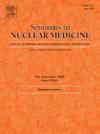CuII-bis(硫脲)配合物:检测神经退行性疾病中氧化应激和神经炎症的潜在放射性示踪剂。
IF 5.9
2区 医学
Q1 RADIOLOGY, NUCLEAR MEDICINE & MEDICAL IMAGING
引用次数: 0
摘要
神经退行性疾病以进行性神经元变性为特征,并伴有神经炎症和氧化应激,在诊断和治疗方面面临重大挑战。这篇综述探讨了铜(II)-双(硫代氨基脲)配合物的潜力,特别是铜- atsm,作为成像和治疗干预的双重用途放射性药物。在线粒体功能障碍和超还原状态的驱动下,Cu-ATSM在病理微环境中表现出独特的氧化还原依赖性保留,这使得通过正电子发射断层扫描(PET)无创性检测氧化应激成为可能。临床前研究表明,其通过抑制神经胶质活化、减少促炎细胞因子(如TNF-α、MCP-1)的分泌、增加神经保护性金属硫蛋白-1 (MT1)的表达来缓解神经炎症。一些临床研究显示,帕金森病(PD)、阿尔茨海默病(AD)和肌萎缩侧索硬化症(ALS)患者26⁴Cu-ATSM摄取升高,与疾病严重程度和区域氧化应激标志物相关。此外,Cu-ATSM衍生物在ALS模型中显示出调节血脑屏障(BBB)通透性、增强淀粉样蛋白-β清除和恢复铜稳态的前景。尽管取得了这些进展,但临床研究中的队列规模小和异质性等局限性强调了更大规模验证的必要性。结合PET和MRI的多模态成像,以及针对β斑块和氧化还原失衡的新型结构类似物,成为未来研究的战略方向。总之,Cu-ATSM代表了阐明神经病理机制和推进神经退行性疾病治疗策略的变革性工具。本文章由计算机程序翻译,如有差异,请以英文原文为准。
CuII-bis(thioureido) Complex: A Potential Radiotracer for Detecting Oxidative Stress and Neuroinflammation in Neurodegenerative Diseases
Neurodegenerative diseases, characterized by progressive neuronal degeneration and associated with neuroinflammation and oxidative stress, present significant challenges in diagnosis and treatment. This review explores the potential of copper(II)-bis(thiosemicarbazone) complexes, particularly Cu-ATSM, as a dual-purpose radiopharmaceutical for imaging and therapeutic interventions. Cu-ATSM exhibits unique redox-dependent retention in pathological microenvironments, driven by mitochondrial dysfunction and hyper-reductive states, which enables the noninvasive detection of oxidative stress via positron emission tomography (PET). Preclinical studies demonstrate its efficacy in mitigating neuroinflammation by suppressing glial activation, reducing the secretion of pro-inflammatory cytokines (e.g., TNF-α, MCP-1), and increasing the expression of neuroprotective metallothionein-1 (MT1). Some Clinical research reveals elevated ⁶⁴Cu-ATSM uptake in Parkinson’s disease (PD), Alzheimer’s disease (AD), and amyotrophic lateral sclerosis (ALS) patients, correlating with disease severity and regional oxidative stress markers. Furthermore, Cu-ATSM derivatives show promise in modulating blood-brain barrier (BBB) permeability, enhancing amyloid-β clearance, and restoring copper homeostasis in ALS models. Despite these advances, limitations such as small cohort sizes and heterogeneity in clinical studies underscore the need for larger-scale validation. Multimodal imaging integrating PET and MRI, alongside novel structural analogs targeting Aβ plaques and redox imbalances, emerges as a strategic direction for future research. Collectively, Cu-ATSM represents a transformative tool for elucidating neuropathological mechanisms and advancing therapeutic strategies in neurodegenerative disorders.
求助全文
通过发布文献求助,成功后即可免费获取论文全文。
去求助
来源期刊

Seminars in nuclear medicine
医学-核医学
CiteScore
9.80
自引率
6.10%
发文量
86
审稿时长
14 days
期刊介绍:
Seminars in Nuclear Medicine is the leading review journal in nuclear medicine. Each issue brings you expert reviews and commentary on a single topic as selected by the Editors. The journal contains extensive coverage of the field of nuclear medicine, including PET, SPECT, and other molecular imaging studies, and related imaging studies. Full-color illustrations are used throughout to highlight important findings. Seminars is included in PubMed/Medline, Thomson/ISI, and other major scientific indexes.
 求助内容:
求助内容: 应助结果提醒方式:
应助结果提醒方式:


